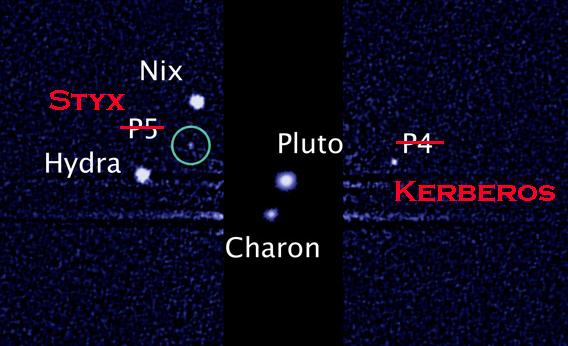Create a free profile to get unlimited access to exclusive videos, sweepstakes, and more!
Pluto Has Moons From Hell

To hell with Plutoâs new moons.
Figuratively, of course. But two newly discovered moons orbiting the distant world now have official (and underworldly) names: Kereberos and Styx.
I approve.
Pluto is pretty smallâ2,300 kilometers (1,430 miles) in diameter, smaller than Earthâs Moonâso it may be surprising it has moons at all. But it has gravity, and it can hold on to smaller bodies ⦠and thereâs plenty of room out there, billions of kilometers from the Sun, so thereâs nothing big enough out there to strip them away, either.
Plutoâs biggest moon is Charon, which is just over half as big as Pluto itself. Thatâs the biggest moon known relative to its parent world! It was discovered in 1978. In 2005, Hubble observations unveiled two more moons, which were named Nyx and Hydra. A fourth moon, provisionally named P4, was found in 2011 and then P5 in 2012.
Get the trend? All the moons are named after characters associated with the Roman god of Pluto, god of the underworld Hades. Charon was the riverboat driver who brought the dead to Hades. Nix is named after Nyx, the goddess of the night, sometimes depicted as a mist that comes from the underworld. (The name is spelled with an i to avoid confusion with an asteroid with that name.) Hydra was a nine-headed dragon that lived in a cave near the entrance to the underworld (and the nine heads were a sly reference to Pluto being the ninth planet).
Kerberos is the name of the three-headed dog guarding the underworld, usually spelled Cerberus (but again, this name was already taken by an asteroid). Styx was the river separating the underworld from the realm of mortals and also a 1970s rock band. That last bit may be coincidence.
I like these names. There was a push in early 2013 to get one of the moons named VulcanâWilliam Shatner liked the ideaâbut that poll was unofficial. However, Commission 46 of the International Astronomical Union, the humor-challenged group of astronomers who decide what gets officially named what, felt that Vulcan is not closely related to Pluto (and again, the name was already in use, an obviously common problem), so they went with Styx.
I like these names. And while the new moons look like mere points of light even using Hubbleâboth are probably only a few dozen kilometers acrossâweâre about to learn a whole lot more about them. Two years from now, in July 2015, the New Horizons probe will zip past the Pluto system, taking the first ever close-up pictures of the iceball and its companions. Itâs not clear what it will find when it gets there, but then thatâs why we explore, isnât it? Even if it takes us to the underworld of the solar system itself.


























